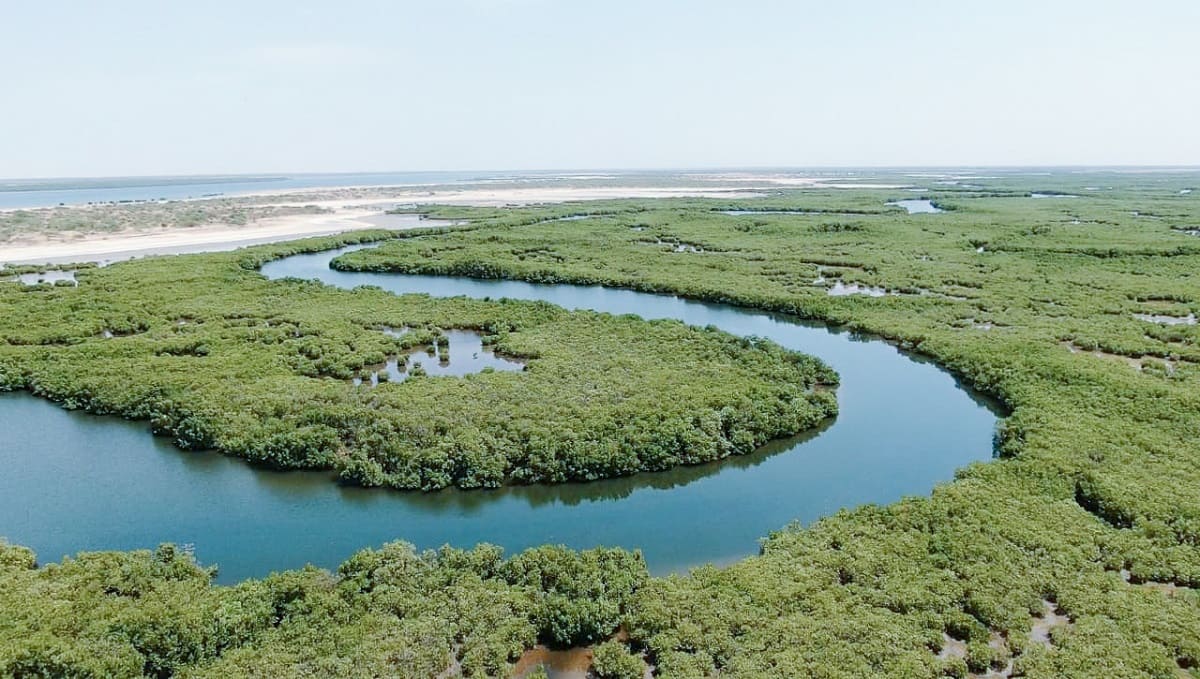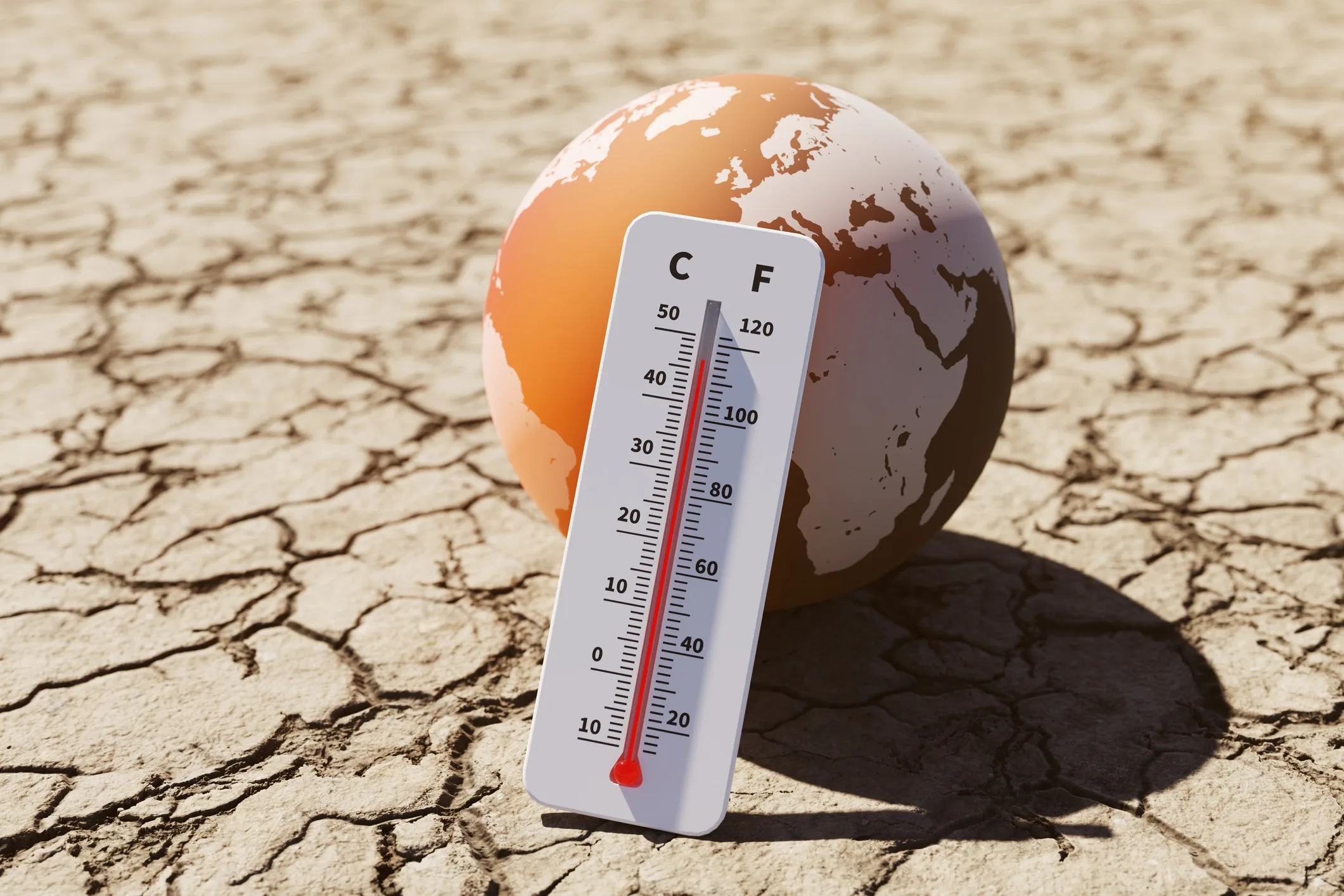Home>Weather and Climate>Understanding The Temperature Of Wetlands: A Comprehensive Guide


Weather and Climate
Understanding The Temperature Of Wetlands: A Comprehensive Guide
Modified: June 2, 2024
Discover the impact of weather and climate on wetland temperatures with this comprehensive guide. Explore the factors influencing wetland temperature dynamics.
(Many of the links in this article redirect to a specific reviewed product. Your purchase of these products through affiliate links helps to generate commission for Temperatures.com, at no extra cost. Learn more)
Table of Contents
Introduction
Wetlands are vital ecosystems that play a crucial role in maintaining the balance of our planet's environment. These diverse and dynamic landscapes are characterized by their unique hydrology, soil, and vegetation, which collectively contribute to their distinct temperature profiles. Understanding the temperature of wetlands is essential for comprehending the intricate interplay of ecological processes within these ecosystems.
The temperature of wetlands influences various biological, chemical, and physical processes, shaping the overall health and functionality of these ecosystems. From supporting diverse flora and fauna to regulating water quality and quantity, temperature exerts a profound impact on the intricate web of life within wetlands.
In this comprehensive guide, we will delve into the multifaceted aspects of wetland temperature, exploring the factors that influence it, the methods used to measure it, and the implications of its seasonal variations. Furthermore, we will examine the profound impacts of climate change on wetland temperature and discuss strategies for managing and conserving these critical ecosystems in the face of environmental challenges.
By gaining a deeper understanding of wetland temperature, we can appreciate the intricate dynamics of these ecosystems and work towards preserving their ecological integrity for future generations. Let's embark on this enlightening journey to unravel the complexities of wetland temperature and its pivotal role in sustaining the delicate balance of our natural world.
The Importance of Wetland Temperature
The temperature of wetlands holds immense significance in shaping the ecological processes and biodiversity within these dynamic ecosystems. It serves as a critical determinant of the overall health and functionality of wetlands, exerting a profound influence on various biological, chemical, and physical aspects. Understanding the importance of wetland temperature is essential for comprehending the intricate interplay of factors that contribute to the vitality of these ecosystems.
Influencing Biological Processes
Wetland temperature plays a pivotal role in shaping the life cycles, behaviors, and distribution of diverse flora and fauna within these ecosystems. It directly influences the growth and reproduction of wetland plants, such as cattails, sedges, and water lilies, which are adapted to specific temperature ranges. Additionally, the temperature of wetlands influences the metabolic rates of aquatic organisms, including fish, amphibians, and invertebrates, thereby impacting their physiological functions and ecological interactions.
Regulating Chemical Reactions
The temperature of wetlands influences various chemical processes, including nutrient cycling, decomposition, and the solubility of gases in water. Temperature directly affects the rates of biochemical reactions, such as photosynthesis and respiration, which are fundamental to the energy flow and nutrient dynamics within wetland ecosystems. Furthermore, temperature variations can impact the solubility of oxygen and other gases in water, thereby influencing the overall water quality and the survival of aquatic organisms.
Shaping Physical Characteristics
The temperature of wetlands influences the physical properties of water, such as its density, viscosity, and thermal stratification. These physical characteristics, in turn, impact the circulation patterns, mixing dynamics, and thermal gradients within wetland water bodies. Temperature also influences evaporation rates, which play a crucial role in regulating the water balance of wetlands and influencing their hydrological connectivity with surrounding landscapes.
Supporting Ecosystem Services
The temperature of wetlands directly influences the provision of vital ecosystem services, including water purification, flood regulation, and habitat provision. By shaping the biological, chemical, and physical processes within wetlands, temperature contributes to the overall resilience and functionality of these ecosystems, thereby enhancing their capacity to provide essential services that benefit both wildlife and human communities.
In essence, the importance of wetland temperature lies in its pervasive influence on the intricate web of life within these ecosystems. By comprehending the multifaceted impacts of temperature, we can gain a deeper appreciation for the delicate balance and ecological significance of wetlands in sustaining the health of our planet.
Factors Affecting Wetland Temperature
The temperature of wetlands is influenced by a myriad of factors that collectively shape the thermal dynamics of these complex ecosystems. Understanding these factors is essential for unraveling the intricate interplay of processes that contribute to the thermal regimes of wetlands. Let's explore the key factors that exert a significant influence on wetland temperature:
Solar Radiation
Solar radiation serves as a primary driver of wetland temperature, exerting a profound influence on the energy balance within these ecosystems. The amount and intensity of solar radiation received by wetlands directly impact the heating of land, water, and vegetation. Additionally, variations in solar radiation due to factors such as latitude, season, and cloud cover contribute to the spatial and temporal heterogeneity of wetland temperature regimes.
Water Depth and Substrate Composition
The depth of water bodies within wetlands and the composition of underlying substrates play a crucial role in regulating temperature. Shallow water bodies tend to heat up more rapidly than deeper ones, leading to spatial variations in temperature within wetlands. Furthermore, the thermal properties of substrates, such as soil and sediments, influence the transfer of heat, thereby impacting the temperature of wetland water bodies and the surrounding environment.
Vegetation Cover
The presence of vegetation, including emergent, submerged, and floating species, influences the temperature of wetlands through various mechanisms. Vegetation provides shade, which can mitigate the heating of water bodies and reduce evaporation rates. Additionally, the transpiration of water by wetland plants contributes to evaporative cooling, thereby influencing the local microclimate and temperature gradients within these ecosystems.
Hydrological Dynamics
The hydrological characteristics of wetlands, including water flow, exchange, and retention, significantly influence their temperature regimes. The movement of water within wetlands, whether driven by tides, currents, or inflows from surrounding water bodies, plays a crucial role in redistributing heat and shaping thermal gradients. Furthermore, the retention of water within wetlands can lead to thermal stratification, creating distinct temperature layers within water bodies.
Climate and Weather Patterns
The broader climate and weather patterns, including air temperature, precipitation, and wind dynamics, exert a pervasive influence on wetland temperature. Seasonal variations, such as winter cold spells and summer heatwaves, directly impact the thermal regimes of wetlands. Additionally, prevailing wind patterns can influence the mixing of air and water, thereby shaping the temperature profiles of these ecosystems.
Human Activities and Land Use
Human activities, such as urbanization, agriculture, and infrastructure development, can significantly alter the temperature dynamics of wetlands. The modification of wetland landscapes, including the construction of impervious surfaces and the alteration of natural drainage patterns, can lead to changes in heat absorption, retention, and dissipation. Furthermore, pollution and nutrient inputs from human sources can influence the thermal characteristics and ecological processes within wetlands.
In essence, the temperature of wetlands is intricately influenced by a diverse array of factors, each contributing to the complex thermal dynamics of these vital ecosystems. By comprehending the multifaceted interplay of these factors, we can gain a deeper insight into the thermal intricacies of wetlands and their pivotal role in sustaining ecological balance.
Methods of Measuring Wetland Temperature
Measuring the temperature of wetlands is essential for gaining insights into the thermal dynamics of these complex ecosystems. Various methods and technologies are employed to assess and monitor wetland temperature, providing valuable data for ecological research, conservation efforts, and environmental management. Let's explore some of the key methods used to measure wetland temperature:
In-Situ Temperature Monitoring
In-situ temperature monitoring involves the direct measurement of water and air temperatures within wetland environments. This method often utilizes temperature sensors, such as thermometers and data loggers, which are deployed at specific locations within wetlands to continuously record temperature data. These sensors can be placed in water bodies, soil, or air, allowing for the collection of spatially and temporally explicit temperature information. In-situ monitoring provides valuable insights into the diurnal and seasonal variations in wetland temperature, offering a detailed understanding of thermal regimes and microclimatic conditions.
Remote Sensing Techniques
Remote sensing technologies, including thermal infrared imaging and satellite-based sensors, are employed to remotely assess wetland temperature patterns over large spatial scales. Thermal infrared cameras and sensors can capture the surface temperature of wetlands, providing thermal maps and spatially explicit temperature data. Satellite-based remote sensing platforms, such as MODIS (Moderate Resolution Imaging Spectroradiometer), enable the monitoring of wetland temperature dynamics at regional and global scales. These remote sensing techniques offer a comprehensive view of temperature variations across diverse wetland landscapes, facilitating the identification of thermal hotspots and the assessment of temperature anomalies.
Hydrological Modeling
Hydrological models, coupled with temperature simulations, are utilized to predict and analyze the thermal characteristics of wetlands. These models integrate hydrological processes, such as water flow, evaporation, and heat transfer, with temperature dynamics to simulate the thermal behavior of wetland ecosystems. By incorporating factors such as solar radiation, water depth, and vegetation cover, hydrological models can provide valuable predictions of wetland temperature patterns under different environmental scenarios. This approach allows for the assessment of temperature responses to hydrological changes and the evaluation of potential impacts on wetland ecosystems.
Citizen Science Initiatives
Citizen science initiatives engage local communities and volunteers in the collection of wetland temperature data, contributing to broader monitoring efforts. Citizen scientists are equipped with simple temperature measurement tools and are trained to record temperature observations across various wetland sites. These collective data provide valuable insights into the spatial distribution of wetland temperature and contribute to long-term monitoring efforts. Citizen science initiatives not only enhance public awareness of wetland temperature dynamics but also foster community involvement in environmental stewardship.
By employing these diverse methods, researchers, conservationists, and environmental practitioners can gain a comprehensive understanding of wetland temperature dynamics, contributing to the effective management and preservation of these critical ecosystems. The integration of multiple measurement approaches allows for a holistic assessment of wetland temperature, enabling informed decision-making and adaptive strategies to address the challenges posed by changing thermal conditions.
Seasonal Variation in Wetland Temperature
Seasonal variation exerts a profound influence on the temperature dynamics of wetlands, shaping the thermal regimes and ecological processes within these vital ecosystems. Understanding the seasonal patterns of wetland temperature is essential for unraveling the intricate interplay of environmental factors and their impacts on the overall health and functionality of wetlands.
During the spring and summer months, wetland temperature undergoes significant fluctuations, driven by the interplay of solar radiation, air temperature, and hydrological dynamics. As solar radiation intensifies and daylight hours lengthen, wetland water bodies absorb heat, leading to an increase in water temperature. This rise in temperature stimulates biological activity, promoting the growth of aquatic vegetation and the proliferation of diverse aquatic organisms. The warm temperatures also contribute to enhanced metabolic rates of wetland flora and fauna, fostering dynamic ecological interactions within these ecosystems.
In contrast, the autumn and winter seasons bring about notable changes in wetland temperature, characterized by cooling trends and thermal stratification. As solar radiation diminishes and air temperatures decrease, wetland water bodies gradually lose heat, leading to a decline in water temperature. This cooling effect influences the behavior and distribution of wetland organisms, triggering seasonal migrations, hibernation, and dormancy. Additionally, the onset of thermal stratification in deeper water bodies creates distinct temperature layers, influencing nutrient cycling and oxygen dynamics within wetlands.
The seasonal variation in wetland temperature profoundly impacts the ecological functions and services provided by these ecosystems. During the warmer months, elevated temperatures support increased biological productivity, contributing to the provision of habitat, food resources, and breeding grounds for diverse wetland species. Furthermore, the thermal conditions influence the water quality and nutrient cycling processes, shaping the overall resilience and functionality of wetlands as vital ecological landscapes.
By comprehending the seasonal variation in wetland temperature, researchers, conservationists, and environmental practitioners can gain valuable insights into the temporal dynamics of these ecosystems. This understanding facilitates the development of adaptive management strategies and conservation measures that account for the seasonal fluctuations in wetland temperature, thereby enhancing the capacity of these ecosystems to withstand environmental changes and sustain their ecological integrity throughout the year.
Impacts of Climate Change on Wetland Temperature
Climate change poses significant challenges to the thermal dynamics and ecological resilience of wetlands, exerting profound impacts on their temperature regimes and associated processes. As global temperatures rise and weather patterns become increasingly erratic, wetland ecosystems are experiencing notable shifts in temperature dynamics, leading to far-reaching consequences for their biodiversity, hydrology, and overall functionality.
One of the primary impacts of climate change on wetland temperature is the alteration of seasonal patterns and thermal regimes. Rising temperatures and changing precipitation patterns disrupt the traditional seasonal temperature fluctuations, leading to extended periods of heat stress and altered thermal gradients within wetland environments. These shifts in temperature regimes can have cascading effects on the phenology of wetland flora and fauna, influencing their reproductive cycles, migration patterns, and overall distribution.
Furthermore, climate change-induced temperature variations can exacerbate the vulnerability of wetland species to environmental stressors. Elevated temperatures can lead to increased thermal stress on aquatic organisms, affecting their metabolic rates, growth, and survival. Additionally, temperature changes can disrupt the delicate balance of wetland food webs, impacting the interactions between species and the availability of essential resources.
The thermal impacts of climate change also extend to the hydrological dynamics of wetlands. Altered temperature regimes influence evaporation rates, water levels, and thermal stratification within wetland water bodies, leading to shifts in nutrient cycling, oxygen dynamics, and the overall water quality. These changes can have far-reaching implications for the ecological functions and services provided by wetlands, including habitat provision, water purification, and flood regulation.
Moreover, the impacts of climate change on wetland temperature can exacerbate existing environmental stressors, such as habitat loss, invasive species encroachment, and pollution. The combined effects of temperature changes and other stressors can challenge the adaptive capacity of wetland ecosystems, potentially leading to disruptions in their ecological balance and the loss of critical biodiversity.
In essence, the impacts of climate change on wetland temperature are multifaceted and far-reaching, posing significant challenges to the ecological integrity and functionality of these vital ecosystems. Addressing these impacts requires concerted efforts to mitigate climate change, enhance the resilience of wetlands, and implement adaptive management strategies that account for the thermal dynamics of these dynamic landscapes. By understanding and addressing the thermal impacts of climate change, we can work towards safeguarding the ecological vitality and sustainability of wetlands in the face of environmental challenges.
Managing Wetland Temperature for Conservation
Managing wetland temperature is paramount for the conservation and preservation of these critical ecosystems. By implementing strategic measures to mitigate the impacts of temperature changes and enhance the resilience of wetlands, conservation efforts can effectively safeguard the ecological integrity and functionality of these vital landscapes.
Restoration of Vegetation Cover
Restoring and conserving the natural vegetation cover within wetlands plays a pivotal role in regulating temperature dynamics. The presence of diverse plant species, including emergent, submerged, and floating vegetation, contributes to shading, evaporative cooling, and the moderation of temperature extremes. Conservation initiatives focused on reestablishing native wetland vegetation can help mitigate the impacts of elevated temperatures, enhance microclimatic conditions, and provide essential habitat and food resources for diverse flora and fauna.
Sustainable Hydrological Management
Implementing sustainable hydrological management practices is essential for regulating wetland temperature and preserving hydrological connectivity. Maintaining natural water flow regimes, minimizing alterations to wetland hydrology, and preserving critical water retention areas are integral to sustaining the thermal dynamics of wetlands. By prioritizing the conservation of wetland hydrological processes, such as water exchange, retention, and circulation, conservation efforts can contribute to the resilience of these ecosystems in the face of temperature variations.
Climate-Resilient Restoration Strategies
Developing climate-resilient restoration strategies that account for temperature dynamics is essential for the long-term conservation of wetlands. Incorporating temperature considerations into wetland restoration projects, such as the selection of plant species adapted to specific temperature ranges and the creation of thermally diverse habitats, can enhance the capacity of restored wetlands to withstand climate-induced temperature changes. By integrating climate resilience into restoration efforts, conservation initiatives can promote the sustainable recovery and functionality of degraded wetland ecosystems.
Community Engagement and Stewardship
Engaging local communities and fostering stewardship of wetlands is instrumental in managing temperature dynamics for conservation. Educating and involving stakeholders in monitoring temperature variations, implementing adaptive management practices, and participating in citizen science initiatives can enhance the collective understanding and stewardship of wetland temperature. Community involvement in conservation efforts can contribute to the long-term sustainability of wetlands and foster a sense of shared responsibility for preserving these invaluable ecosystems.
Adaptive Monitoring and Management
Adopting adaptive monitoring and management approaches that account for temperature dynamics is essential for effective conservation. Regular monitoring of wetland temperature, coupled with adaptive management strategies that respond to temperature-related changes, enables conservation practitioners to assess the impacts of temperature variations and implement targeted interventions. By integrating adaptive approaches into conservation practices, stakeholders can proactively address the thermal challenges faced by wetlands and promote their ecological resilience.
In essence, managing wetland temperature for conservation requires a multifaceted approach that integrates ecological restoration, sustainable hydrological management, climate-resilient strategies, community engagement, and adaptive monitoring. By prioritizing the preservation of temperature dynamics within wetlands, conservation efforts can contribute to the resilience and sustainability of these vital ecosystems, ensuring their continued capacity to support diverse flora and fauna while providing essential ecological services for the benefit of present and future generations.
Conclusion
In conclusion, the temperature of wetlands is a critical determinant of their ecological health and functionality, exerting profound influences on biological, chemical, and physical processes within these dynamic ecosystems. From shaping the life cycles of diverse flora and fauna to regulating nutrient cycling and water quality, wetland temperature plays a pivotal role in sustaining the delicate balance of these vital landscapes.
The multifaceted factors that influence wetland temperature, including solar radiation, water depth, vegetation cover, and climate patterns, collectively contribute to the thermal dynamics of these ecosystems. Understanding the seasonal variations in wetland temperature is essential for unraveling the temporal intricacies of these landscapes and developing adaptive management strategies that account for the dynamic thermal regimes.
Furthermore, the impacts of climate change on wetland temperature pose significant challenges to the ecological resilience of these ecosystems, leading to disruptions in thermal regimes, hydrological dynamics, and the overall functionality of wetlands. Addressing these impacts requires concerted efforts to mitigate climate change, enhance the resilience of wetlands, and implement adaptive management strategies that account for the thermal dynamics of these critical landscapes.
Effective conservation and management of wetland temperature are essential for preserving the ecological integrity and functionality of these vital ecosystems. By restoring vegetation cover, implementing sustainable hydrological management practices, developing climate-resilient restoration strategies, engaging local communities, and adopting adaptive monitoring and management approaches, conservation efforts can contribute to the resilience and sustainability of wetlands in the face of environmental challenges.
In essence, the comprehensive understanding and management of wetland temperature are integral to the preservation of these invaluable ecosystems. By prioritizing the conservation of temperature dynamics within wetlands, we can work towards safeguarding their ecological vitality and ensuring their continued capacity to support diverse flora and fauna while providing essential ecological services for the benefit of present and future generations.









